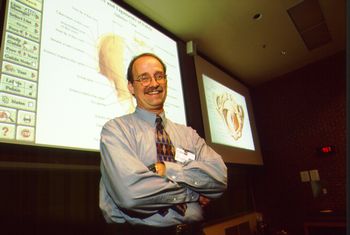Gross anatomy courses go high-tech

A CD-ROM program developed by Art Dalley, Ph.D., is helping first-year medical students get a handle on the basics of human anatomy. (Photo by Donna Jones Bailey)
Walk into a gross anatomy class in 202 Light Hall these days and you might think you've accidentally stumbled onto the bridge of the Starship Enterprise.
Thanks to the efforts of new Cell Biology Professor Art Dalley, Ph.D., these courses ‹ required of all first-year medical students ‹ have gone decidedly high-tech, trading in chalkboards and erasers for state-of-the-art, interactive computer-based learning.
Through the Frank H. Netter Interactive Atlas of Clinical Anatomy, a CD-ROM program Dalley conceived, edited and developed over a two year period with a team of programmers, the students now have anatomical drawings, comparative X-rays, CT scans, a layer-by-layer cross sectional view of the human body from head to toe adapted from the National Library of Medicine's Visible Human Project, and an accompanying tutorial with each clinical illustration all at their fingertips.
Until this year Vanderbilt medical students received the lecture portion of gross anatomy via chalkboard drawings and myriad handouts. But even though anatomy instruction has gone high tech, the students still must put in their time in the cadaver lab.
"I had the idea for a long time for a program that would allow you to bring up anatomical plates and clinical plates at the same time," Dalley said. "I wanted something more than just a software companion to a text."
The information can be presented to students in a variety of ways and allows the instructor to easily prepare lectures or tailor them on the fly.
"We use this program in place of the old slides and drawings we used to use. The program also allows the instructor to go into a specific series of drawings of a given part of the body and pick and choose," he said. "It also allows the instructor to select labels for the drawings as they see fit."
Fellow gross anatomy instructor Lillian B. Nanney, Ph.D., Professor of Cell Biology and Plastic Surgery, is a big fan of the new teaching tool.
"I¹m really impressed with the computer program. Anatomy is such a visual discipline and this allows greater use of multiple visual aids," she said. "In teaching anatomy, a picture is worth a thousand words and this is a big help."
Nanney said the students no longer have to pause for her or one of the other instructors to draw illustrations on the board. "The students no longer have to wait on me, and that¹s what¹s fun. I can get to the point quicker," she said.
The podium in 202 Light Hall now has a built-in computer that runs the program from the instructor¹s monitor. The lecture hall boasts two large video screens to project comparative and contrasting images. In addition, the room now has an ELMO visual presenter, a sort of high tech overhead projector that allows the instructor to show transparencied, conventional drawings, X-rays, or three-dimensional objects to the whole class.
"We¹ve included a lot of radiologic images in the lessons this year. With The Visible Human Project, which shows a head to toe sectional slice of real tissue, we can incorporate a corresponding anatomical slice or CT scan. When a student is just beginning to learn cross sectional anatomy the sections can look like steak to them. With this program they can look at a corresponding illustration or anatomical slice, and at the comparative radiological image to help orient them," he said.
Dalley says that the new students wouldn¹t necessarily know that until this academic year gross anatomy was taught by chalkboard drawings and handouts.
"The new students were dazzled by the technology the first couple of days, now they accept it," he said. "It helps them because they have access to the program in the computer lab located near the gross anatomy lab, and some of them have even bought a copy to use at home."
The interactive program easily allows students to develop quizzes and tests to help them study. "The students can develop these quizzes testing each other and the program will keep score," Dalley said.
Another feature of the program allows the instructor to save their lecture to disk where it can then be put on a server allowing students access from their computers.
"It¹s a real plus for the students to be able to go back to the computer lab after the lecture and rerun the lesson at their own speed. The learning is more dynamic." Nanney said.
In addition to being the editor of the CD-ROM version of the Frank H. Netter Interactive Atlas of Clinical Anatomy, Dalley is also the editor of a companion text to the computer program that was just released in July titled Frank H. Netter Atlas of Anatomy, Second Edition which features plates of Netter¹s anatomical drawings.
"This is a very nice teaching tool, and a pleasure to get to use it. The program was released on the market last summer and is doing quite well. It¹s the best-selling CD-ROM in medicine after Harrison¹s Medical Dictionary and Stedman¹s Medical Dictionary," Dalley said. "For an instructor it takes a little getting used to, but this has so many advantages to it compared to a slide projector.
"For today¹s gross anatomy course I think it really helps to have all that clinical information at your finger tips."













